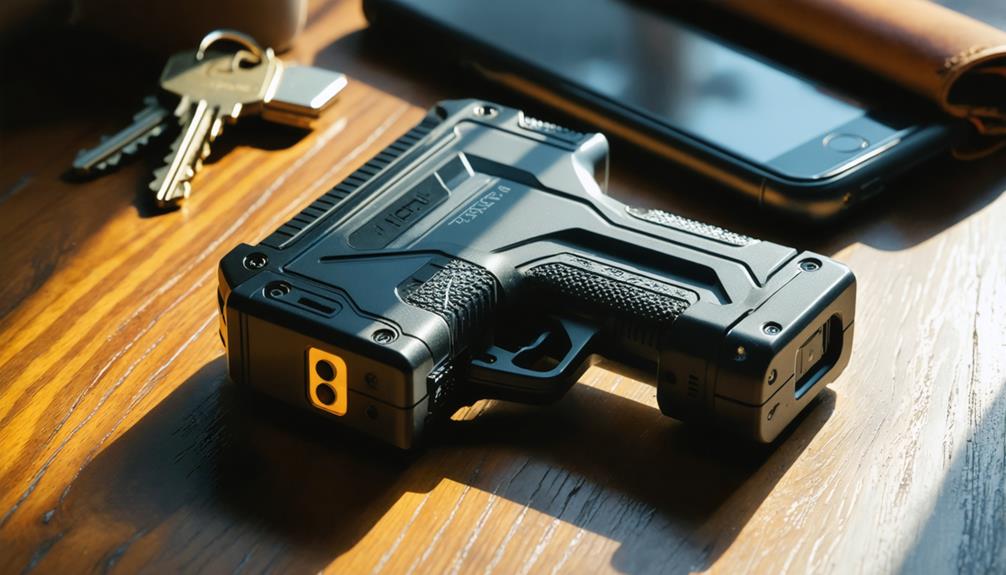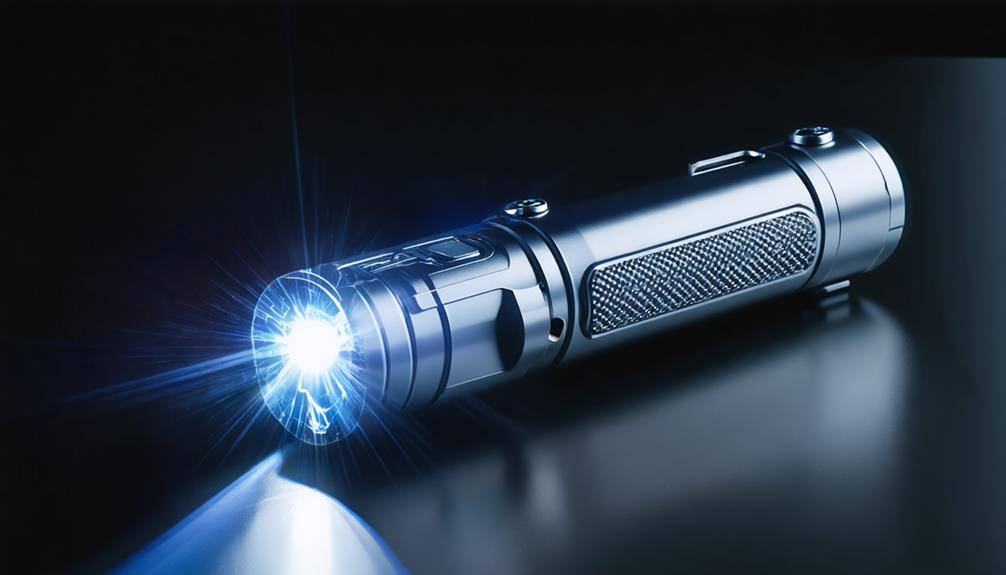
Brainstorm Security Shop

For Orders Over $199

On Any Of Our Products

Details On Refund Page

Stun guns are increasingly popular for personal defense due to their ability to incapacitate attackers without causing permanent harm. However, their legal status and the ethical implications surrounding their use present a complex landscape. As society grapples with the balance between safety and regulation, understanding the nuances of stun gun technology becomes paramount. Exploring how these devices function, the legalities involved, and their role in both civilian and law enforcement contexts opens up a multifaceted debate. What are the real implications of their widespread adoption, and how do we navigate the intricacies of effective yet ethical self-defense?
Stun gun technology, frequently misunderstood yet critical in the realm of personal security, relies on a straightforward principle: delivering a high-voltage electrical shock to an assailant to temporarily incapacitate them. These devices are designed to disrupt the body’s muscular and neurological systems, providing a non-lethal means of self-defense.
Understanding the various stun gun types is essential for users to select the most appropriate model for their needs. The most common stun gun types include handheld models, often compact and portable, and stun batons, which provide extended reach.
Handheld stun guns are highly effective due to their accessibility and ease of use, making them suitable for a wide range of users. Meanwhile, stun batons offer additional safety by allowing the user to maintain distance from a potential threat.
The effectiveness of stun guns is largely determined by the voltage delivered and the duration of contact with the target. High-voltage stun guns can incapacitate an assailant quickly, although even lower-voltage models can be effective with prolonged contact.
Ultimately, the effectiveness of a stun gun also depends on the user’s ability to deploy it confidently and strategically in a high-stress situation.
While understanding stun gun technology is vital for proper usage, it is equally important to be aware of the legal landscape governing their possession and use. Stun guns, as non-lethal self-defense tools, are subject to a complex array of state regulations that vary significantly across jurisdictions. It is crucial for individuals to familiarize themselves with the specific laws in their residing state to ensure compliance and avoid legal repercussions.
Some states impose strict regulations on the possession and use of stun guns, while others offer more lenient frameworks. For instance, certain states may require permits, background checks, or registration for stun gun ownership, mirroring the requirements for firearms. In contrast, other states might impose outright bans on these devices, considering them dangerous weapons. Understanding the nuances of state regulations is essential for responsible ownership.
Moreover, self defense laws play a pivotal role in determining the legal use of stun guns. These laws typically dictate when and how force can be used in self-defense scenarios, which can influence the legitimacy of using a stun gun in confrontational situations.
As such, individuals must stay informed about both state regulations and applicable self defense laws to ensure responsible and legal usage.
The advantages of using stun guns as self-defense tools are manifold. One of the most significant benefits is their ability to provide a non-lethal means of protection, ensuring personal safety without causing permanent harm to an assailant. This characteristic makes stun guns an attractive option for individuals seeking to protect themselves while minimizing legal and ethical concerns associated with more lethal forms of self-defense.
Stun guns are designed to incapacitate attackers temporarily, allowing individuals to escape potentially dangerous situations. This feature enhances their effectiveness as self-defense tools, providing users with a crucial window to seek safety or contact authorities.
Furthermore, their compact and portable nature means they can be easily carried in purses, pockets, or bags, making them readily accessible when needed.
Another advantage of stun guns is their deterrent effect. The mere presence of a stun gun can discourage potential attackers, who are often wary of encountering resistance. This psychological impact can prevent confrontations from escalating, thus preserving personal safety without the need for physical engagement.
Additionally, stun guns require minimal training to operate effectively, making them suitable for individuals of various ages and physical abilities.
Despite the numerous benefits associated with stun guns, it is important to acknowledge the potential risks and safety concerns they present. Primarily, health effects are a significant concern. Although designed to be non-lethal, stun guns can still cause unintended harm. Individuals with underlying health conditions, such as heart problems or epilepsy, may face severe consequences if subjected to the electric shock delivered by a stun gun. The sudden jolt can potentially trigger cardiac arrhythmias or seizures, leading to critical health situations.
Additionally, misuse scenarios pose substantial risks. Stun guns, if not used correctly, can cause injury not only to the intended target but also to the user. Improper handling or deployment in high-stress situations may lead to accidental discharges, resulting in unintended harm.
Furthermore, the potential for misuse extends to situations where individuals may use stun guns irresponsibly or for malicious purposes, leading to abuse and illegal activities.
Thus, while stun guns serve as effective self-defense tools, it is crucial to weigh these risks and use them responsibly. Comprehensive training and awareness are essential to minimize health effects and prevent misuse scenarios, ensuring safety for all parties involved.
How have stun guns become integral tools in modern law enforcement? Over recent decades, stun guns have emerged as essential non-lethal options for police officers seeking to subdue suspects without resorting to firearms.
The effectiveness of stun guns lies in their ability to temporarily incapacitate individuals through electric shock, allowing officers to gain control of volatile situations while minimizing the risk of serious injury to both the suspect and themselves. This capability is especially valuable in urban environments where the potential for harm to bystanders is high.
A critical component of leveraging stun gun effectiveness is comprehensive officer training. Law enforcement agencies emphasize rigorous training programs to ensure officers understand both the mechanics and the appropriate contexts for deploying stun guns.
This instruction includes practical scenarios, legal guidelines, and ethical considerations, aiming to equip officers with the knowledge to make split-second decisions accurately. Moreover, continuous training updates are essential to keep pace with technological advancements in stun gun design and functionality.
While stun guns are not without controversy, their role in law enforcement continues to evolve. By focusing on officer training and responsible use, agencies can maximize the benefits of these devices, enhancing safety and maintaining public trust.
Self-defense tools vary in effectiveness, legality, and safety. When comparing options, one must consider stun gun laws and stun gun safety, ensuring compliance with regulations while prioritizing personal protection and minimizing risks to both users and targets.
Utilizing self-defense tools on animals for protection involves understanding animal behavior and ethical considerations. While some tools may deter aggressive animals, careful assessment is crucial to ensure humane treatment and compliance with legal and ethical standards.
Proper maintenance is crucial for any device to ensure reliability. Regularly check battery care by replacing or recharging as needed. Adhere to safety precautions by inspecting for damage, ensuring components are secure, and storing appropriately to prevent misuse.
Yes, there are different models designed specifically for personal stun guns and professional stun guns. Personal stun guns emphasize portability and ease of use, while professional stun guns offer enhanced features for law enforcement or security personnel.
Extreme weather conditions can significantly affect device efficiency. For stun guns, efficiency may be compromised by factors such as moisture or extreme cold, which can impact electrical discharge reliability and overall performance in various environmental scenarios.
Brainstorm Security Shop
1867 Caravan Trail
Ste 105
Jacksonville, FL 32216
Call us toll free: (800) 859-5566